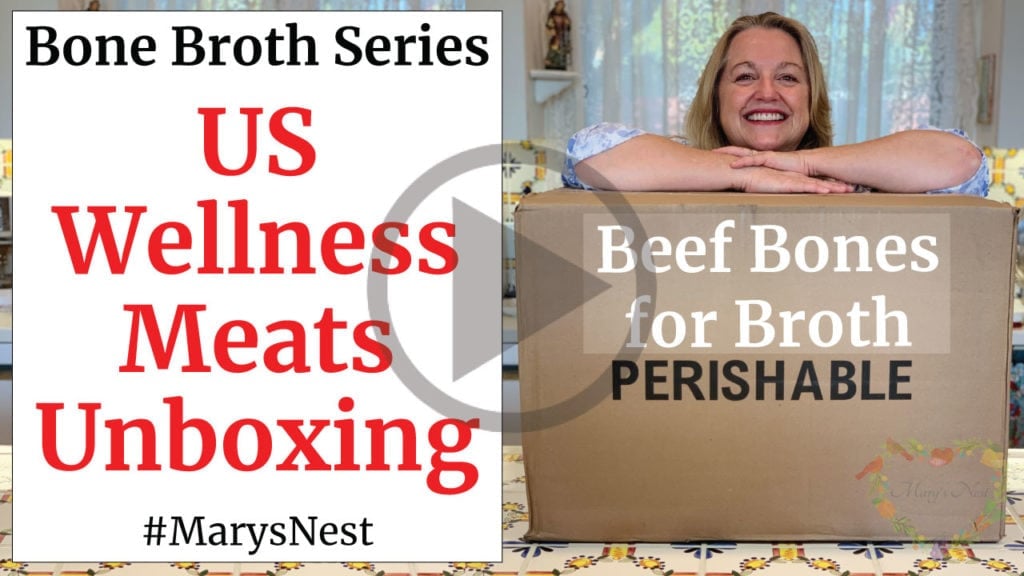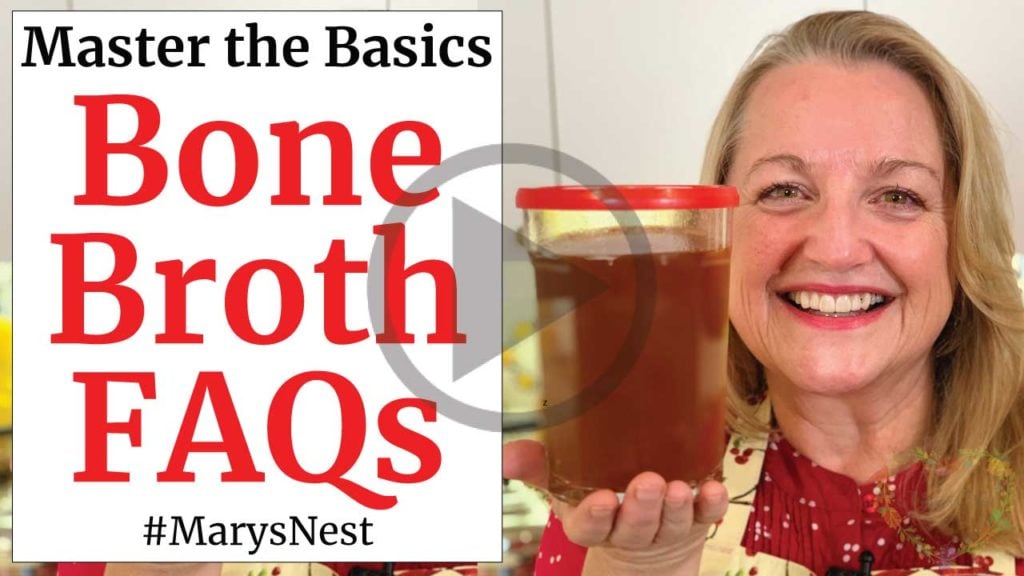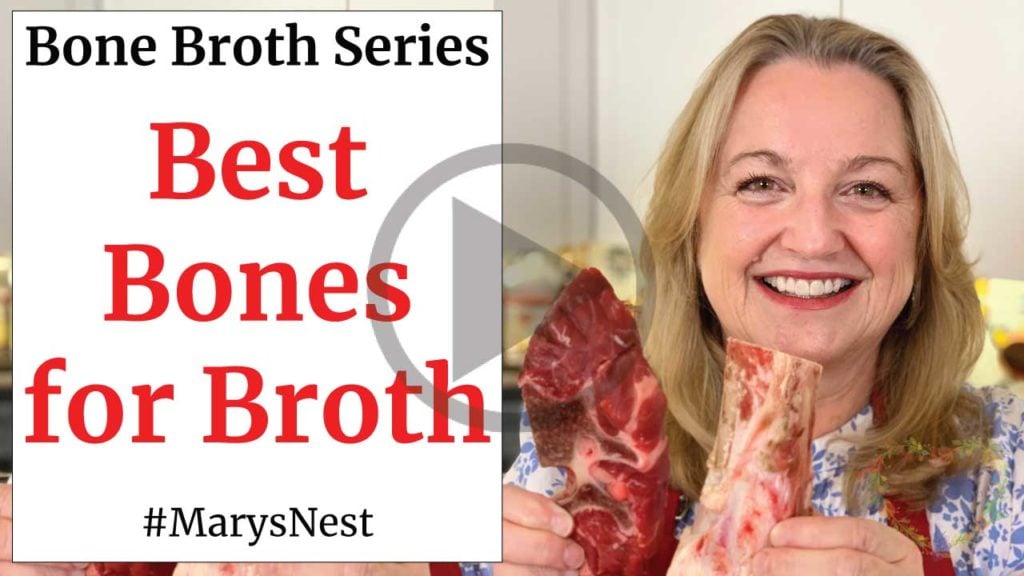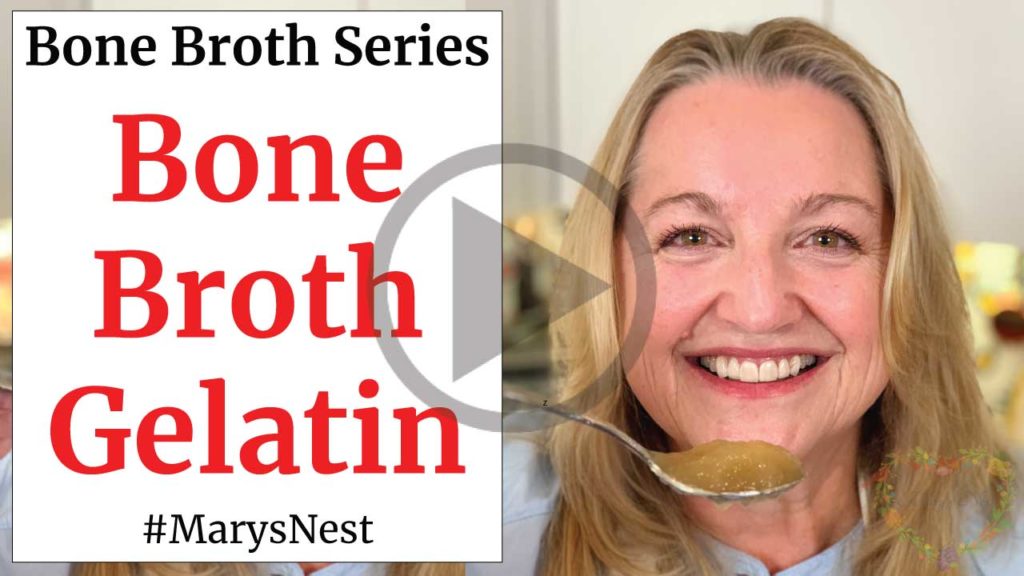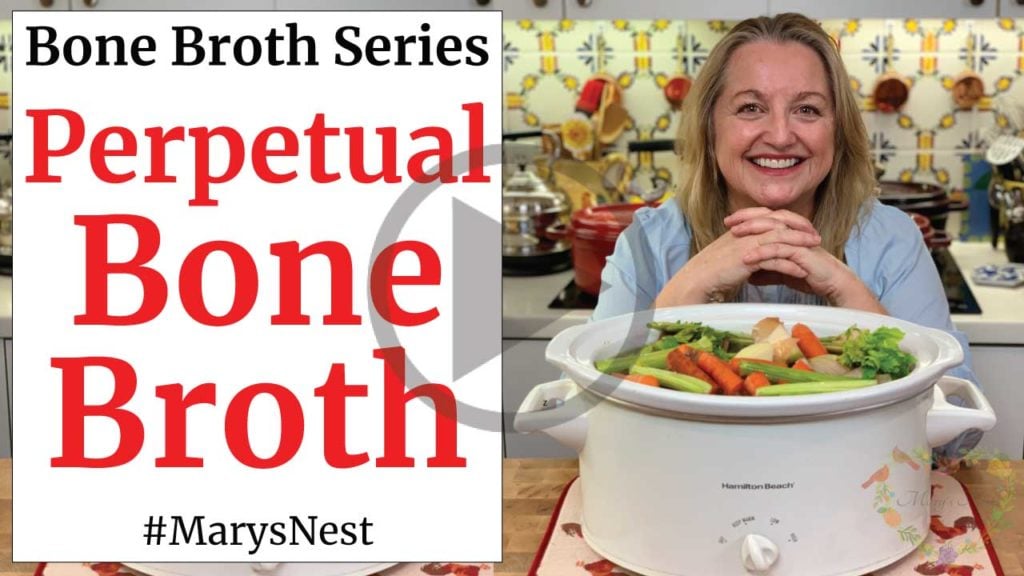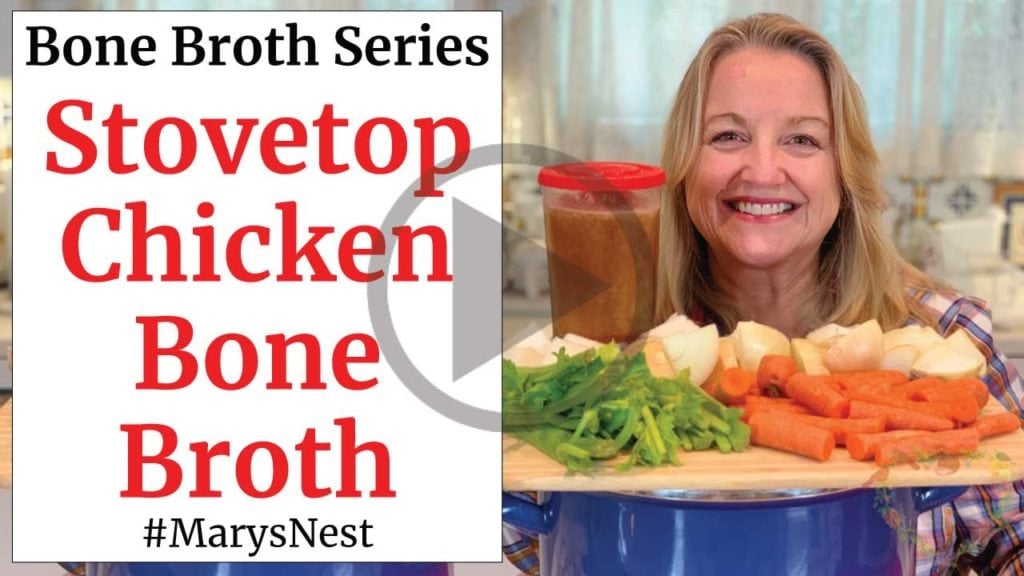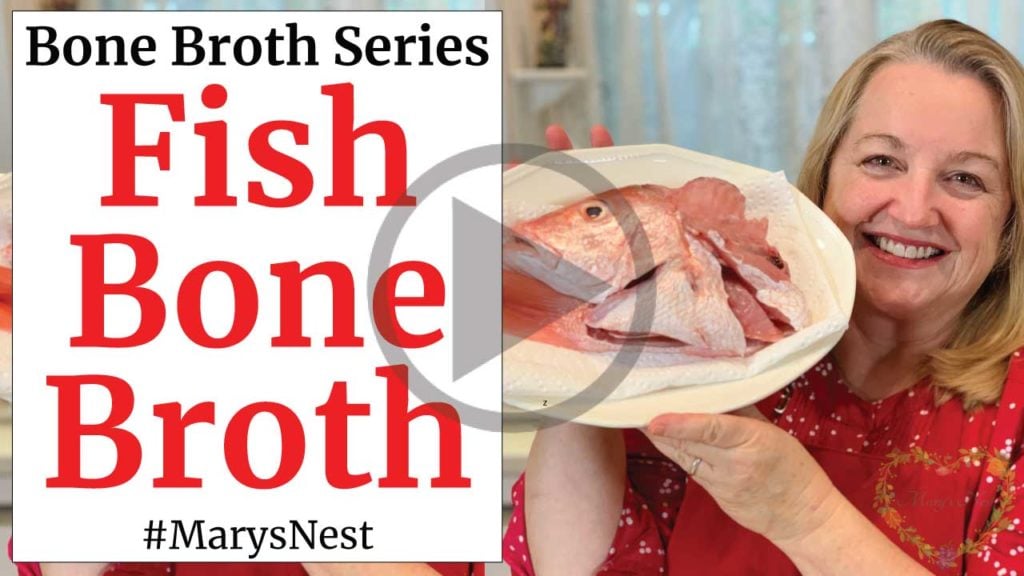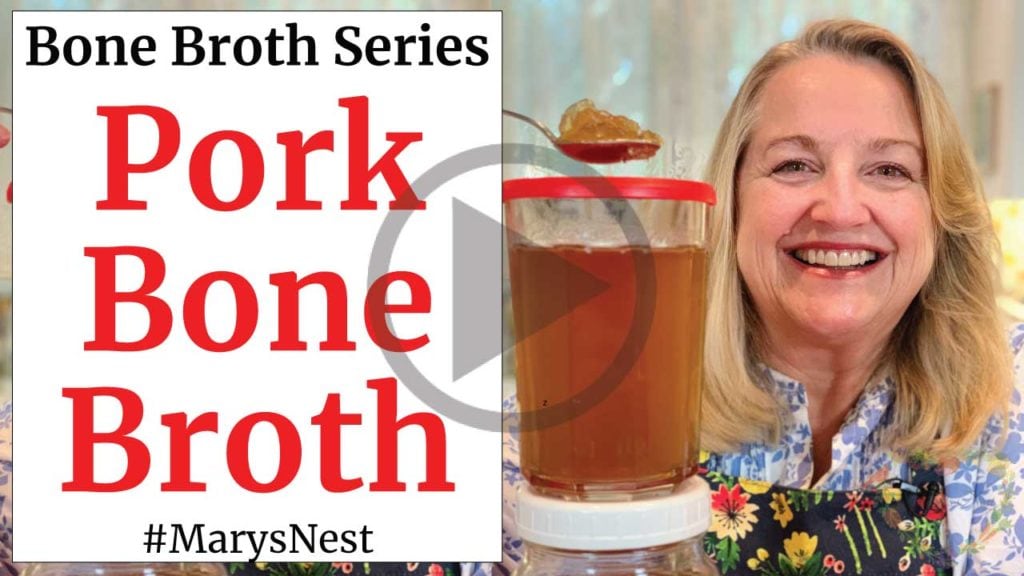Affiliates note: As an Amazon Associate I earn from qualifying purchases. My content may contain affiliate links to products and services. If you click through and make a purchase, I'll receive a small commission. It does not affect the price you pay.
What is the Difference Between Broth, Stock, and Bone Broth?
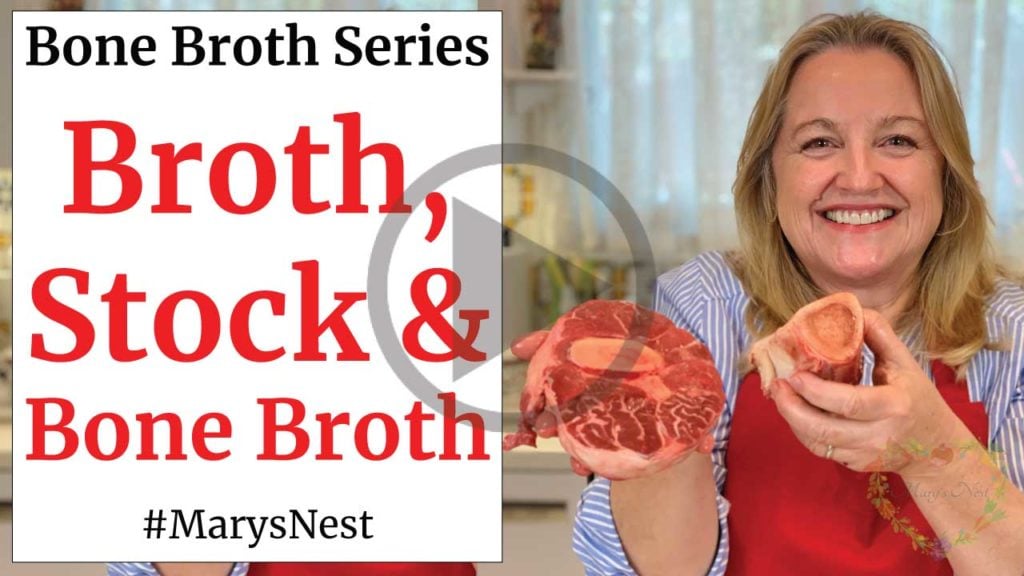
I want to share with you an overview of the differences between Broth, Stock, and Bone Broth. There is quite a bit of confusion about these three types of nutritious liquids, so it is important to understand the differences and the role that each plays in the Traditional Foods Kitchen. I also include links to detailed videos to help you learn how to make each of the liquids.
Broth, Stock, and Bone Broth
To begin with, let’s go over the basics of each of these:
- Broth – Is primarily made with meaty bones.
- Stock – Is primarily made with bones that have little or no meat on them.
- Bone Broth – Is a combination of the two, meaty bones and bones with a little meat on them. Plus, Bone Broth includes high cartilage bones, which help to create the rich gelatin that’s associated with this liquid.
What Are the Benefits of Broth?
Broth contains high amounts of protein thanks to the significant amount of meat that’s used to make it. For example, to make Chicken Broth, the home cook will often use an entire chicken. Once you make this Broth, you can remove the meat from the chicken and use the chicken meat in a variety of recipes, including adding it to a soup that uses your newly created Broth. What a great combination!
When making Beef Broth, the same is true. You’ll use a generous amount of meat and little bone to make Broth. Shank bones are excellent beef bones for making Beef Broths.
In addition to its high protein content, another benefit of Broth is that you can make it in as little as 45 minutes, unlike bone broth, which can take much longer.
What Are the Benefits of Stock?
Stock doesn’t have the same high protein content as Broth, but it has a higher amount of gelatin. The bones used in Stock contain collagen, and once cooked, collagen creates gelatin. Although the amount of collagen is not as high as the amount of collagen in cartilage, stock bones contain enough collagen to produce a nutritious semi-gelatinous liquid that soothes our “gut” and nourishes our joints, skin, hair, and nails.
Generally, home cooks make Stock by browning bones, such as marrow bones in the case of making Beef Stock. The rich color and taste of Stock give gravies and sauces a wonderful flavor. And the best part? Stock can also be ready in a short amount of time—anywhere from as little as two hours, but no more than three hours.
Bone Broth – The Best of Both Worlds
The term “Bone Broth” can be confusing because many wonder…is it a stock or a broth? And that is completely understandable! The great news is that it is both.
What Bones Should I use for Beef Bone Broth?
Use the following bones to make Beef Bone Broth:
- Meaty bones, such as shanks,
- Non-meaty bones, such as marrows, and
- High-cartilage bones, such as oxtails, knuckles, and patellas. (This is the most important ingredient!)
Because of the variety of bones, this wonderful elixir contains high amounts of protein and gelatin. Thanks to the addition of the high-cartilage bones, we significantly increased the level of collagen in Bone Broth, as compared to the amount of collagen in Stock. (I also have a video that shows you the Best Bones for Making Beef Bone Broth.) This extra boost of collagen is what creates a very gelatin-rich Bone Broth, making it a superior choice for significantly nourishing our gut, joints, skin, hair, and nails, as opposed to Stock.
What Bones Should I use for Chicken Bone Broth?
When it comes to making Chicken Bone Broth, I recommend using the carcass of three chickens that will have some bits and bobs of meat left on them. You will also want to add in some high-cartilage bones, such as necks, backs, wingtips, or chicken feet (my favorite)! All of these high-cartilage bones will help you make a wonderfully gelatinous Bone Broth.
Is There a Downside to Making Bone Broth?
So what’s the downside to making Bone Broth? It takes more time to make Bone Broth than Broth or Stock. You could argue that it’s not really a downside considering the highly nutritious liquid that you are creating. However, that said, Chicken Bone Broth will take up to 6 hours to make, and Beef Bone Broth will take a full 12 hours to make.
An Excellent Source for Beef Bones and More
If you can’t find organic beef bones or other beef, lamb, pork, poultry, or seafood products from your supermarket or farmer’s market, you can order these products online from US Wellness Meats. I’ve been a happy customer of theirs for many years, and in the video below, you’ll see how they pack their products with care to keep your items cold during shipping.
If you order from US Wellness Meats, be sure to use promocode MARYNEST and my link to save 15% off regular-priced items on your US Wellness Meats order.
Broth, Stock, and Bone Broth Videos
After viewing my video where I go over the difference between Broth, Stock, and Bone Broth, watch the videos below to learn how to make one of these nutritious liquids at home. By learning these essential kitchen skills, you’ll discover the benefits these liquids provide to help you prepare traditional “nutrient dense” meals!
- Beef Broth Videos
- Beef Stock Videos
- Beef Bone Broth Videos
- Chicken Bone Broth Videos
- Fish Bone Broth Videos
- Pork Bone Broth Videos
- Turkey Bone Broth Videos
You can enjoy these liquids in your cooking for making soups, stews, gravies, and sauces. They can also be a great substitute in place of water when cooking grains. But best of all, you can enjoy any one of these in a mug—just for sipping—with a pinch of sea salt.
Beef Broth Videos
Beef Stock Videos
Beef Bone Broth Videos
Chicken Bone Broth Videos
Fish Bone Broth Videos
Pork Bone Broth Videos
Turkey Bone Broth Videos
Stay in Touch with Mary’s Nest
- Subscribe to My YouTube Channel for Traditional Foods Videos (Free) - When you subscribe, be sure to click on the notification bell that will let you know each time I upload a new video.
- Subscribe to Mary’s Traditional Foods Newsletter (Free) - Get a free 36-page eBook for signing up: How to Stock Your Essential Traditional Foods Four-Corners Pantry.
- Join the Traditional Foods Kitchen Academy - For more detailed videos and exclusive members-only perks, join my YouTube membership community.
- Order The Modern Pioneer Cookbook - Get a hardcover book of Mary's nourishing recipes from a Traditional Foods Kitchen. This bestselling cookbook is published by Penguin Random House with their DK imprint.
- Order The Modern Pioneer Pantry - Get Mary's latest hardcover cookbook about preserving food and making delicious meals from your Four Corners Pantry. Mary's second cookbook is also published by Penguin Random House.
I look forward to having you join me in my Texas Hill Country Kitchen!
Shop for items used in this blog post or video
Benefits of a Fat Separator
In many of my Bone Broth videos, you’ll see me using a Fat Separator to help remove all the fat from my Bone Broth so that I can decant a nicely clarified end product.

The Fat Separator is a clever design that you can fill with your liquid. After a few moments, the fat will rise to the top of the liquid, and you can press a lever that opens a hole on the bottom. This enables you to drain your de-fatted bone broth into the vessel of your choosing. (I use glass storage jars with plastic lids.) I love this device!
Favorite Bone Broth Making Supplies
- 7-Quart Slow-Cooker
- 8-Quart Slow-Cooker
- 10-Quart Slow-Cooker
- Fat Separator
- Stainless Steel Strainer
- Flour Sack Towels
- Two Cup Glass Storage Jars with Lids
- One Cup Glass Storage Jars with Lids
- Half Gallon Storage Jar
- Wide Mouth Plastic Storage Lids
Recommended Reading
Amazon Shop and Shopping Guide
- Visit Mary’s Nest Amazon Shop
- Visit my Shopping Guide page
Get up to 15% off for stocking your Traditional Foods Pantry and equipping your Modern Pioneer Kitchen, including discounts from US Wellness Meats, Farmhouse Teas, Backwoods Home, Masontops, Cultures for Health, Survival Garden Seeds, Redmond Real Salt, Mother Earth News, and More!
Affiliates note: As an Amazon Associate I earn from qualifying purchases. My content may contain affiliate links to products and services. If you click through and make a purchase, I’ll receive a small commission. It does not affect the price you pay.
Disclaimer:I am not a medical doctor, a medical professional, a dietician, or a nutritionist. All content found on the MarysNest.com website, including text, images, videos, eBooks or eGuides, social media, or other formats, were created solely for informational purposes only. The content is not intended to be a substitute for professional medical advice, diagnosis, or treatment. Always seek the advice of your physician or other qualified healthcare provider with any questions you may have regarding a medical condition or proper nutritional advice. Never disregard professional medical advice or delay in seeking it because of something you have watched in a video or read on this website. Use caution when following the recipe in this video. The creator and publisher of this video and website will not be held responsible for any adverse effects that may arise from the use of this recipe and method or any other recipe and method on this website or corresponding video channel.
